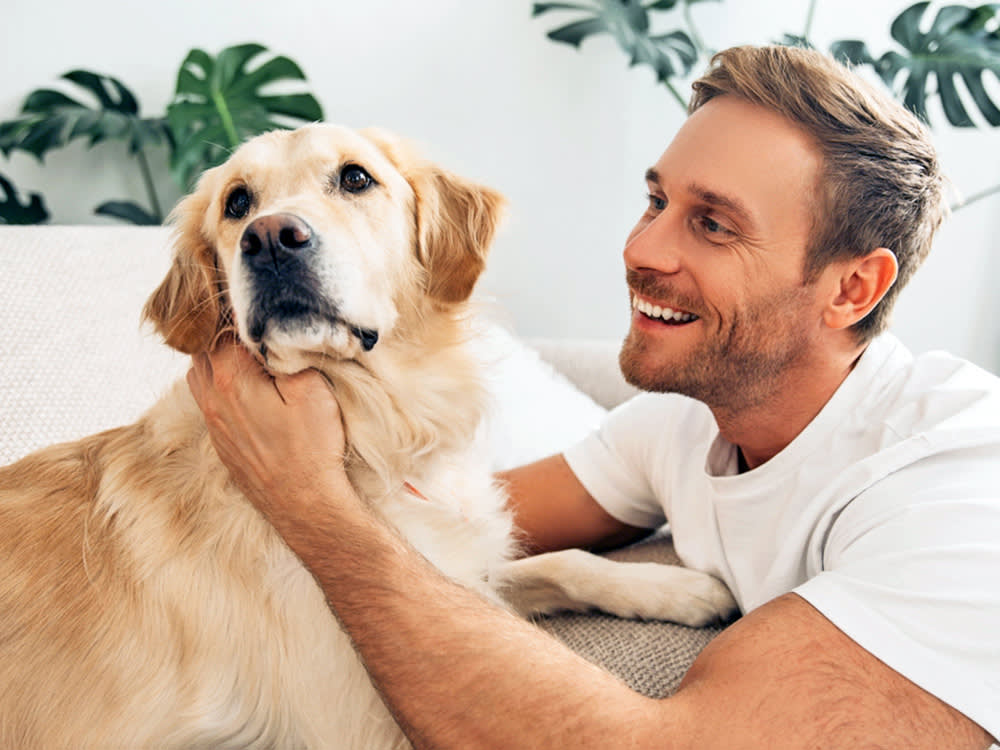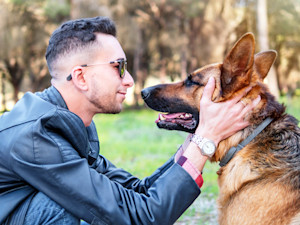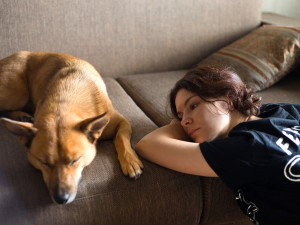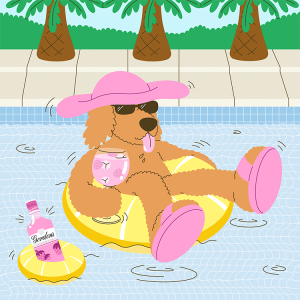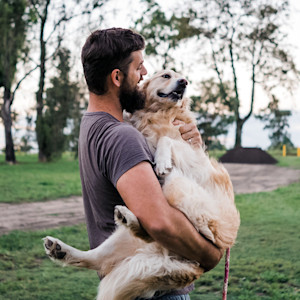Why Do So Many Dogs Hate Men?
It’s not just the mailman.
It’s the kind of joke that writes itself: Dogs hate men? Relatable!
Yes, yes, I know, #NotAllMen, but apparently, #NotAllDogs got the memo. Research has confirmed what many a dog parent has likely already noticed: A lot of dogs seem to get cagey around men, no matter how wonderful they might be on the inside. For example, one studyopens in new tab published in 1999 suggested that dogs “may be more defensively aggressive towards men than women.” But why is that?
We might not be able to read dogs’ minds, but experts can at least come up with a few plausible hypotheses as to why so many dogs seem to throw their hackles up the moment even the sweetest man walks through the door. They also have a few suggestions for dog parents hoping to make their pups tolerate men better.
Why are so many dogs afraid of men?
As fun as it might be to joke about how our dogs hate all men, Dr. Zenithson Ng, clinical professor for the Department of Small Animal Clinical Sciences at the University of Tennessee’s Institute of Agriculture College of Veterinary Medicine, emphasizes that it’s important not to generalize that all dogs hate men or to stereotype men as inherently threatening.
How much do you spend on your pet per year?
“Instead,” Dr. Ng says, “we must recognize that certain characteristics or behaviors more commonly associated with some men may act as unintentional triggers for specific dogs.”
Ugh, fine. With that in mind, here are a few reasons your dog might get timid around (some) men.
They could be affected by a lack of socialization.
It’s hard to overstate how important the socialization period can be in shaping your dog’s relationship with the world around them. This is when we introduce dogs to new things and help them build positive associations. Dogs who’ve missed out on this process can wind up fearful of their surroundings and people — including, perhaps, men.
According to Dr. Ng, puppies up to 16 weeks old need to be gently and positively exposed to a wide variety of stimuli, including people, animals, sounds, and new environments. “These early, positive experiences help build confidence and reduce the likelihood of fear-based behaviors later in life,” he says.
They’ve had negative past experiences.
Your dog doesn’t need to have a horror-movie, chased-by-a-man-with-a-chainsaw past to build up negative associations. They can occur in everyday life, too.
For instance, Dr. Wayne Hunthauseopens in new tab n, veterinarian and owner of Westwood Animal Hospital, says that if a bookshelf falls and there happens to be a man in the room, that could be enough. More direct experiences can do it as well — like if your dog gets stuck under a fence and a man helps him get free, causing some unintentional pain in the process.
Dogs can make all kinds of generalizations like these, Dr. Ng says, including from certain characteristics like age, gender, body type, voice pitch, clothing style, or scent.
Genetics and temperament could play a role.
All dogs are individuals, so they are all predisposed to behave differently. Genetic predispositions and environmental context can play a role in shaping their reactivity to certain stimuli — like strange dudes in their space. According to Dr. Ng, “dogs with a naturally cautious temperament or those raised in limited or inconsistent social environments may be more prone to fear-based reactions.”
Physical appearance and body language also matter.
As anyone who has hung out with a dog for any period of time has probably realized, they notice everything. According to Dr. Ng, human cues like posture, movement patterns, facial expressions can all register on the doggie radar. And as Dr. Hunthausen notes, men are larger, taller, and can show up with features like long facial hair. If they happen to be wearing a hat or carrying tools, “that could be unfamiliar to the dog and feel threatening.”
Remember: Your dog can also smell way better than you can, which means that male pheromones can be enough to intimidate them. “Additionally,” Dr. Ng says, “some men may naturally use more assertive body language when approaching dogs compared to women — such as direct eye contact, faster movements, or confident postures — which can be misinterpreted by a fearful or anxious dog as a sign of dominance or threat.”
Fascinatingly, a 2008 studyopens in new tab found that when point lights were attached to male and female figures as they walked, observers perceived the male walkers to be walking toward them and the women to be walking away. Most of us, presumably including dogs, are more likely to feel intimidated by a figure approaching us than one that is walking away.
Tone of voice could trigger them.
Our pups are also sensitive to tone of voice, and as Dr. Hunthausen points out, “Men tend to be a little bit louder, deeper voices.”
The “delivery man problem” is a thing.
These days, it isn’t only men who walk up to the house and deliver strange packages before walking away. But still, Dr. Hunthausen says, a lot of delivery workers happen to be male. “They run up to the house, they might ring the bell. They never come in. They run away,” he says. “So, the dog sees a man over and over again, and maybe he's not exposed to men in general, and the only men he sees are ones at ‘X’ range.”
All of that said, however, Dr. Ng points out that men are not necessarily the most frightening demographic to haunt our furry babies: “The even more common demographic group I find many dogs fearful of are children.”
How can I help my dog feel less afraid of men?
So, your dog barks up a storm whenever a man approaches. Honestly, who doesn’t? (Sorry — all of Dr. Ng’s cautions aside, I’ll never be able to resist the delectable taste of low-hanging fruit.) Thankfully, there are steps you can take to help your dog deal with the existence of men.
“The key is using counterconditioning and positive reinforcement,” Dr. Ng says, “teaching the dog that good things happen when the fearful stimulus (men) are around.”
Control the environment.
When it comes to dogs, exposure therapy is never the answer. At least, not in the “sink-or-swim” way some of us might’ve learned during our own childhoods. Instead, Dr. Hunthausen says, you should start by regulating your dog’s surroundings to reduce exposure to their triggers — in this case, men.
“Then there is the other side of the coin,” Dr. Hunthausen says, “which is, what can we do in a safe, slow way to make positive associations with the appearance of men or people in general?”
Build their confidence at home.
If you’re expecting a male guest, Dr. Hunthausen suggests moving your dog to a safe, quiet place before the visitor even pulls into the driveway. That way, he says, we can “avoid all the excitement and anxiety associated with somebody being in the home.”
Set up a quiet zone with a radio and a nice attention-consuming toy, like a Kong filled with cheese. “Then,” Dr. Hunthausen says, “we can bring the person in quietly, and we’re going to place them on a chair or sofa as far as possible from wherever the pet’s going to be brought into the room.” Have your guest ignore the dog and avoid eye contact once they enter.
As you bring your dog into the room, have them sit for treats every few paces. You can usually get within 10 feet of your guest, who should continue ignoring the dog. Then, sit with your dog and allow your guest to start flipping high-value treats (like chicken or a very occasional piece of hot dog) directly toward the dog without looking at them or making a big gesture. Over time, they can flick the treats closer and closer to themselves, allowing the pup to approach as they feel comfortable.
Once your dog comes within three feet of the guest, Dr. Hunthausen suggests switching to a recall game: Call your dog back to you, have them sit, and give them a piece of food. Then, have your guest call your dog and drop a high-value treat on the floor. Once your pet gets comfortable, you can start playing the game with both you and the guest standing up so that your dog gains experience with a man standing in a more “threatening” posture.
Finally, you can try putting a slow feeder or maze bowl on the floor near the male guest or family member to see if the dog feels comfortable sitting near them for a prolonged period of time while the humans in the room socialize.
Take baby steps outside.
Not everyone has a lot of regular guests, so maybe implementing this training at home isn’t going to work for you. Instead, you can work on counter-conditioning in public.
“Start by identifying what specifically triggers the dog’s fear,” Dr. Ng says. “Is it a man’s voice, size, facial hair, or quick movements?” Figure out your dog’s “fear threshold,” meaning the distance at which your dog can be in the presence of a man and still feel calm, and work below that. Avoid crossing their limits.
“Each time the dog stays relaxed in the presence of a man, immediately reward them with something they love, such as high-value treats, gentle praise, or a favorite toy,” Dr. Ng says. “Over time, the dog will begin to associate men with positive experiences and calm behaviors rather than fear.”
Don’t force interactions by, say, having a man approach your dog. Instead, Dr. Ng adds, have a man stand quietly at a distance and ignore the dog while tossing treats toward them. “As the dog gains confidence, you can gradually decrease the distance and increase the level of interaction at your dog’s pace.”
You can also reward your dog for reacting calmly to male passersby. Bring along high-value treats and watch for any time they orient their body toward a man in their surroundings. When they do, Dr. Hunthausen says, have them sit and stay before rewarding them with a treat. Maintain a positive voice throughout the process and keep your demeanor calm. Don’t shower your dog in training cues like “look at me” whenever a man crosses your path. That can stress them out, which is the opposite of what you want.
When should you see a vet?
As with most behavioral issues, it’s best not to wait too long before seeking professional help. Without proper help, the problem can easily escalate.
“If you start to notice any signs of fear or aggression toward people, it’s important to act quickly rather than waiting for the behavior to go away,’” Dr. Ng says. “Early intervention makes a big difference.”
If your dog seems very fearful around men, Dr. Ng suggests reaching out to your veterinarian as well as a certified behaviorist, or a positive-reinforcement trainer to help pinpoint their triggers and create a plan to address them. Your veterinarian can also rule out medical issues that might be contributing to the anxiety and prescribe medications as needed.
“The sooner you intervene,” Dr. Ng says, “the better the chances of helping your dog feel secure and comfortable around all types of people.”
